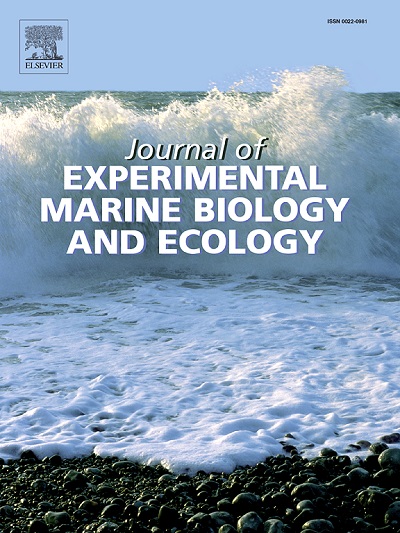加州海狮的断奶年龄取决于繁殖地的纬度
IF 1.8
3区 生物学
Q3 ECOLOGY
Journal of Experimental Marine Biology and Ecology
Pub Date : 2024-09-26
DOI:10.1016/j.jembe.2024.152059
引用次数: 0
摘要
海狮断奶的年龄在不同年份和不同种群之间会有很大差异。这是一个重要的生命史参数,受到环境条件的影响,并能驱动海狮数量的变化。然而,要知道断奶开始和结束的时间却很难确定。我们开发了一种方法(使用傅立叶分析法),可根据在墨西哥三个繁殖地出生的幼年加州海狮的桡骨δ15N图谱的变化来确定哺乳期。我们将 15 只幼年加利福尼亚海狮(年龄约为 12 个月)的腕蹼切成 33-74 段,每段重量相近。我们测量了每个鳃裂片的 δ15N 和 δ13C 值,并根据特定地点的鳃裂片生长率为每个鳃裂片指定了日期。我们还将幼体振膜上与幼体阶段相对应的δ15N图谱与来自同一群落的成年雌性振膜的δ15N值进行了比较,以验证傅立叶分析所确定的从牛奶到鱼类的饮食过渡。我们发现,不同群落的幼体开始用鱼类补充奶食的时间不同--3-5个月大(圣埃斯特万岛)、5-7个月大(圣玛格丽塔岛)和> 12个月大(洛斯岛)。所有幼崽断奶时都已 1 岁。墨西哥较长的哺乳期与美国太平洋沿岸(圣米格尔岛)北部加州海狮群落较短的 10-11 个月断奶期形成鲜明对比。不同地区哺乳期的差异可能反映了海洋生产力的纬度差异,以及墨西哥加州海狮可获得的猎物营养质量较低。我们的研究增加了对加州海狮断奶期的有限了解,并为确定其他物种的断奶期提供了一种方法。本文章由计算机程序翻译,如有差异,请以英文原文为准。
Age at weaning of California sea lions depends on colony latitude
The age at which sea lions wean can vary significantly between years and among populations. It is an important life-history parameter that is influenced by environmental conditions and can drive changes in sea lion numbers. However, knowing when weaning begins and ends is difficult to determine. We developed a method (using Fourier analysis) to identify the lactation period from changes in the δ15N profiles of vibrissae from juvenile California sea lions—born in three colonies in Mexico. We sectioned vibrissae from 15 juvenile California sea lions (aged approximately 12 months) into 33–74 segments of similar weight. We measured δ15N and δ13C for each vibrissa segment and assigned dates to each one using site-specific vibrissa growth rates. We also compared the δ15N profiles that corresponded to the pup stage on the juvenile vibrissae with δ15N values of adult female vibrissae from the same colonies to validate the dietary transition from milk to fish identified by the Fourier analysis. We found that pups began supplementing their milk diet with fish at different times between colonies—ranging from 3 to 5 months old (San Esteban Island), 5–7 months old (Santa Margarita Island), and > 12 months old (Los Islotes Island). All pups were > 1 year old when weaned. The longer lactation period in Mexico contrasts with the shorter 10–11 months age at weaning recorded at northern colonies of California sea lions along the US Pacific coast (San Miguel Island). The difference in lactation duration among regions likely reflects latitudinal differences in marine productivity, and a lower nutrition quality of prey available to California sea lions in Mexico. Our study augments the limited knowledge of weaning in California sea lions and provides a means to determine weaning in other species.
求助全文
通过发布文献求助,成功后即可免费获取论文全文。
去求助
来源期刊
CiteScore
4.30
自引率
0.00%
发文量
98
审稿时长
14 weeks
期刊介绍:
The Journal of Experimental Marine Biology and Ecology provides a forum for experimental ecological research on marine organisms in relation to their environment. Topic areas include studies that focus on biochemistry, physiology, behavior, genetics, and ecological theory. The main emphasis of the Journal lies in hypothesis driven experimental work, both from the laboratory and the field. Natural experiments or descriptive studies that elucidate fundamental ecological processes are welcome. Submissions should have a broad ecological framework beyond the specific study organism or geographic region.
Short communications that highlight emerging issues and exciting discoveries within five printed pages will receive a rapid turnaround. Papers describing important new analytical, computational, experimental and theoretical techniques and methods are encouraged and will be highlighted as Methodological Advances. We welcome proposals for Review Papers synthesizing a specific field within marine ecology. Finally, the journal aims to publish Special Issues at regular intervals synthesizing a particular field of marine science. All printed papers undergo a peer review process before being accepted and will receive a first decision within three months.

 求助内容:
求助内容: 应助结果提醒方式:
应助结果提醒方式:


